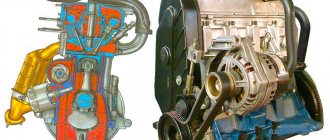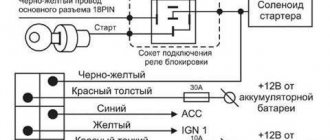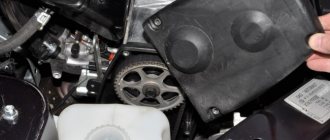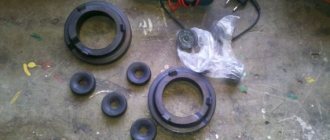Replace damaged hoses or gaskets, replace hose clamps
Lada Granta cars have a fairly high share in the total flow of vehicles on Russian roads. However, this affordable sedan, despite the many introduced innovations and modern technological solutions, is characterized by a number of typical breakdowns and problems. Including those related to the transmission, or rather, the gearbox.
Weaknesses of the Lada Granta automatic transmission
The Grant model was the first brainchild of the AvtoVAZ concern, which was equipped not only with the old proven version of the manual transmission from the “ten”, but also with a completely modern version of the “automatic”. After a thorough study of the world market, the engineers responsible for the transmission units of the new model made their choice in favor of the high-quality Japanese unit JATCO JF414E. The same automatic transmission, by the way, is installed on Nissan Almera and a number of other cars that have a very high reputation all over the world.
But in the case of Lada Granta, things did not work out from the very beginning. The settings of the Japanese unit did not want to be “friendly” with the Russian-made engine. The problem was partially solved by attracting specialists from the Austrian company AVL. But some problems with the Lada Granta automatic transmission could not be resolved. The most characteristic signs of failure of the “automatic machine” on the Lada Grant and ways to eliminate them are the following.
- No forward movement when reverse gear is working properly. This indicates either a breakdown of the friction discs, or a rupture of the piston cuff, or a failure of the o-rings. However, often it is enough to simply clean the valve that regulates gear shifting.
- Complete immobilization of the vehicle. In most cases, this means the need to replace clutches.
In order to avoid a rather expensive diagnostic procedure, overhauling the automatic transmission and replacing individual parts, it is necessary to change the oil in the gearbox as often as possible. Despite the fact that the manufacturer claims uninterrupted operation with a mileage of 150-180 thousand km, the transmission oil must be changed as soon as it acquires a dirty gray color and begins to release fine fractions onto the crankcase.
Do-it-yourself absorber valve replacement
If signs of malfunction are detected, the valve will need to be repaired or replaced. The adsorber valve is inexpensive and easy to replace. To dismantle you need to have a pair of Phillips screwdrivers and know where the canister purge valve is located. Operating procedure:
The markings on the old and new valves must match.
- Open the hood and find a cylindrical device - an adsorber.
- Remove the negative terminal from the battery.
- Disconnect the wire block by pressing the latch and pulling it towards you.
- Loosen the valve.
- Remove the fittings under the latch and disconnect the hoses.
- Remove the valve together with the bracket from the adsorber.
- The new valve is installed in the reverse order.
Thus, even such a small element as the adsorber valve performs important functions and its malfunction can seriously disrupt the operation of the entire engine. Therefore, it is important to monitor the condition of your car and carry out diagnostics on time.
So, I promised to describe in detail the problem I once had with the CPA. Writing.
Oh, that canister purge valve! The only breakdown that somewhat overshadowed the generally cloudless ownership of the Grant... There was a whole epic with it. And it was like this.
Exactly closer to 50,000 miles, the car began to periodically glitch and drive poorly, as if it had lost 30% of its power. The revolutions dropped sharply when coasting (as soon as you released the gas, the tachometer needle fell down) and even during acceleration the revolutions could sag slightly and float. Acceleration was very slow. For example, in order to accelerate 10-20 km in 4th gear, the automatic transmission was forced to switch to 3rd gear and turn the engine at 4000+ rpm. There was simply no way to improve otherwise. At the same time, the car howled and hummed loudly (there was a characteristic sound of air flow - like in a vacuum cleaner hose) and did not drive properly. And when driving, it felt as if you were driving not a small, light Grant, but a heavy truck. I also had a strong feeling that when I pressed the gas, someone was holding the brake a little. Well, it can’t be the same? It was terribly annoying! And most importantly, at first the glitch was floating. During one trip the car could malfunction all the way, it could be released unexpectedly at any moment, or it could not be released until the next trip. The car could drive normally for several days or malfunction for several days.
They looked for the reason for a long time, about 3 months. There were no receipts. The OD looked at my husband and me with sad eyes. They listened, shook their heads, and in the end they said, “Well, it’s going wrong, it’s not clear, if it breaks down completely and stops going, then come back,” and they sent me home. Commercial services also couldn’t say anything, or even suggest WHAT it could be. So we started looking for ourselves. First, we went through the brake system to eliminate the influence of jamming of the handbrake and brakes. Replaced the handbrake cable. The rear brake pads, as it turned out, were already time to be changed, so they were replaced. The front was normal, they just checked it and left it as is. Then we did everything ourselves, because... they sent us to the services with our trouble.
Read more: Granta pros and cons reviews
A friend suggested changing the air filter, so they did. Nothing was named. They began to dig deeper.
By that time, it was already clear that the problem was related to excess air entering the intake manifold, i.e. the mixture became lean. By the way, my gas mileage was surprisingly low back then. On the highway about 6 liters of 95, in mixed mode - no more than 6.5 liters. Next, we began to turn off the oxygen flow sensors sequentially and tried driving without them. Nothing changed, the car continued to malfunction, i.e. it wasn't about them. Replaced the air flow sensor with a new one. Nothing has changed either.
And finally we got to the KPA. My husband bought a new KPA “Utes” from Kalina because there was no other one in the store, but the sellers claimed that it would also be suitable for Grant. We adjusted it and went to test it. And again Nothing happened, the car was absolutely glitchy. So what is it? And then a miracle happened - after a few minutes of driving with the Utes, the CHECK light came on for the first time! The check told us about the incorrect air flow through the control unit. Those. Too much or too little air is passing through the valve. As a result of subsequent experiments, it turned out that the Kalinovsky CPA on Grant does not have enough voltage to operate and does not open at all. Then we took radical measures to check whether the problem was still with the CPA. We turned off the KPA completely and drove off without it. And OH MIRACLE, the car picked up and drove again as before! The difference in the ride before and after was obvious and felt very clearly, even from the passenger seat.
Next, the husband removed the Kalinovsky CPA, tightened the adjusting screw on it, and screwed it back into the car. We went to test it again, the car began to drive almost as before, but it was clearly not completely cured. Then the husband connected from the phone to the car and to the assistant. The diagnostic program looked at how the control valve works in different driving modes and with the car standing and controlled the opening and operation of this valve at a given percentage. This allowed us to visually study how this valve works, how it should work and how it fails for us. In general, with the Kalinovsky KPA, the car never drove normally. They spat, bought another CPA, from Grant, installed it and thus completely cured the car. The car just flew like new! And my happiness knew no bounds! After replacing the KPA with an adequately functioning one, gasoline consumption increased slightly - now 6.8-7.2 in the combined cycle. I drive a 95. Here's the story.
Problems with the Lada Granta manual transmission
The manual transmission installed on Lada Granta cars is much cheaper to operate and maintain than the Japanese “automatic”. But it also has characteristic “diseases” that have been inherent in this unit since the release of the “ten” family:
- tight handle movement and even freezing at low temperatures;
- noise, crackling and howling in the gearbox;
- spontaneous shutdown of speeds.
The causes of such malfunctions, as well as the methods for eliminating them, can be completely different. But the most typical prerequisites for the occurrence of the symptoms described above are the following.
- Insufficient oil level in the gearbox. Often, adding oil allows you to get rid of extraneous sounds, grinding and noise. If this procedure does not improve the situation, then the problem is most likely wear of the bearings or gears. In this case, the worn-out parts must be immediately replaced.
- Incomplete release of the clutch. This is the most common reason for difficulties associated with shifting gears, excessively tight movement of the lever or its “sticking”. In such cases, as a rule, it is impossible to do without reassembling the box. However, the peculiarities of the “mechanics” installed on Lada cars are such that the problem can arise due to relatively minor problems - loosening of the fastening screws, slight deformation of the rod, or incorrect adjustment of the drive.
Spontaneous “flight” of gears in most cases indicates damage or wear of the teeth of the gear synchronizer and clutch. This is a fairly serious breakdown, directly related to safety. Therefore, worn or damaged parts must be replaced as soon as possible.
Thus, the transmission of the Lada Granta, both with an automatic transmission and a manual one, cannot be called perfect. However, its maintainability indicators are incomparably higher than those of previous models of AvtoVAZ products.
Malfunctions of the adsorber valve and their elimination
Almost continuous operation of the fuel vapor absorption system canister can cause damage to the purge valve. A malfunction of the canister valve often leads to damage to the fuel pump. Due to poor ventilation of the adsorber, gasoline accumulates in the intake manifold, the engine loses power, and fuel consumption gradually increases. This may cause the engine to stop completely. The operation of the entire vehicle depends on how the adsorber valve works.
How to check the functionality of the canister purge valve?
Checking the absorber valve
In order to notice and correct problems in time, regular checks of the adsorber valve are necessary. In this case, a breakdown can be identified by certain indirect signs. When the engine is idling or in cold weather, the vapor absorption system makes characteristic sounds, like the canister valve clicking. Some people confuse this sound with a faulty timing belt, rollers or other parts. You can check this by sharply pressing the gas pedal. If the sound has not changed, it means the canister valve is clicking. Experts can explain what to do if the canister valve knocks too loudly. To do this, you need to tighten the adjusting screw, and first it is cleared of epoxy resin.
The absorber valve can be adjusted.
The screw turns approximately half a turn. If you tighten it too much, the controller will generate an error. This adjustment of the adsorber valve will make its operation softer and the knocking noise quieter. However, how to check the adsorber valve for damage? Valve failure can be determined using an error diagnostic system or mechanical testing. Electronic error codes are stored in the controller's memory and indicate electrical damage. To check the valve, it is recommended to pay attention to errors generated by the controller, such as “open circuit of the canister purge valve control circuit.” Signs by which a malfunction of the adsorber valve can be mechanically determined:
- The appearance of dips at idle speed of the engine.
- Very low engine thrust.
- There is no sound of valve operation when the engine is running.
- A hissing sound when the gas tank cap is opened indicates a vacuum in the system. This is a sure sign of a malfunction in the adsorber ventilation.
- The appearance of a fuel smell in the car interior. However, its appearance can also be caused by other reasons.
Read more: Mitsubishi Lancer 9 what oil to use
Children's diseases Lada Granta - main problems and ways to solve them
Russian-made cars have long been on the path to improving manufacturing quality. For about ten years, production capacity has been updated and the VAZ Corporation’s model range has been actively changing. However, budget cars, on which you have to save on literally every component and unit, are not free from childhood diseases. Today we will talk about common problems of one of the most popular cars in Russia. This is the Lada Granta - the cheapest car that is worth paying attention to on the Russian market. Price competitors of the Grants are only compatriots or even notorious Chinese, so the car has practically no rivals on the market. Its appearance is quite modern, its technology has been modified to meet the requirements of the present time.
But the factory was not without significant problems, which somewhat reduce the pleasure of operating the car. For example, there are a number of childhood diseases that occur in almost every car produced. In most cases, these problems do not become fatal to the car and its performance, but they clearly do not increase the driver’s enjoyment of using the car. It’s time to boldly talk about the shortcomings of domestic cars; perhaps these cries will be heard by the plant, which will review the problematic components and assemblies in the next generation. If you have a Lada Granta at your disposal, join the discussion of children's problems and car diseases by leaving your comments on this publication.
Relatively poor build quality is the bane of Russian cars
Lada Granta was no exception to the general rule. The build quality of the car is only slightly better than the layout of the “Tenth” family of cars. The company made significant changes to its production capabilities, consulting with experts from Renault and Nissan to look for problems in the assembly lines. But it was not possible to significantly improve the quality of the layout, welding and tightening of bolts for the Lada Granta. This car has its own serious problems associated with not very high-quality assembly:
- when driving you have to listen to a symphony of hard plastic, which rubs against other elements of the cabin with not very pleasant sounds;
- some fasteners have to be tightened every 5-10 thousand kilometers so that no components and assemblies fall off along the way;
- We recommend that you pay special attention to the engine compartment; if you hear rattling or vibration in this place, you should arm yourself with a wrench and a screwdriver;
- welding work at the plant was also not carried out using the latest technologies; sometimes Granta owners report the need to weld the car in the first year;
- in the cabin you can find a lot of shortcomings in the assembly process, but most of these problems can be fixed with your own hands without any effort.
It seems that the car does not undergo any certification at all. Lada Granta is one of the hopes of the domestic automobile industry; today it is the concern’s best-selling car, as well as one of the most popular participants in the Russian vehicle market. And even taking into account all these factors, the plant does not care too much about the quality of the car. It’s time to equip the assembly process with inspectors who will find every minor flaw and send the car back to the assembly shop for revision. True, in this case the Lada Granta will significantly lose its attractive price.
Generator - the main childhood disease of the first modification Grants
Every third owner of a Lada Granta car in the very first issue became a victim of a low-quality generator. Today, these components manufactured by Bosch are installed on cars, but the first cars rarely reached 15-20 thousand kilometers with an old generator under the hood. So this is one of the most serious and frequent “bugs” in the work of Russian VAZ engineers.
However, this problem was resolved quite simply. It is necessary to change the generator to the one that is installed on Lada Granta today. The German quality of this unit has made problems with the generator very rare, at least that’s what employees of service centers and official service stations say.
Thermostat is a traditional disease of Russian cars
Another unpleasant component that incredibly often fails on modern modifications of the Granta is the thermostat. This problem is common to all Russian-made cars. Often, after several tens of thousands of operation, the thermostat refuses to turn on a small circle of coolant flow. Therefore, in winter it is almost impossible to properly warm up the car.
In 2012, AvtoVAZ reported replacing the type of thermostat and making major changes to its design. True, since then there have been no fewer requests for warranty repairs of this unit. For now, the only correct way out of the situation is to install a German-made analog thermostat - such an expensive move completely eliminates this problem.
Overall build quality. "Krutilki" fly out of their seats
Well, the build quality of Lada cars has really improved. They obviously don't hammer bolts anymore with sledgehammers. Nevertheless, users of the new Lada Granta still have questions about the model’s everyday reliability. Here's what Drom reported about this:
“...as soon as I decided to move the headlight range control to the zero position, its handle remained in my hands...”
The guys, so as not to be unfounded, even recorded this problem on video:
Video taken from YouTube channel Dromru
As you know, where one “twist” has fallen off, the second one will also fall off... Be careful!
Body corrosion is an integral part of Grants
Almost all Lada Granta owners are faced with body problems that lead to the need for constant repairs, touch-ups and restoration. If you miss the moment when rust began to spread in your car, it will be extremely difficult to correct the consequences or stop the corrosion. The body of the Lada Granta is not protected from corrosion at all from the factory, even though such an item is included in the package. Many owners speak in reviews and interviews about the following problems of the domestic bestseller:
- in the first year of operation, the car requires body work, unpleasant moments, pockets of rust and other problematic areas appear;
- the quality of painting is very low, new chips and scratches constantly appear, which even arise from contact with bugs on summer roads;
- traces of corrosion appear under the plastic elements of the body, rust appears very quickly above the wheel arches, at the bottom of the doors and on the sills;
- when a source of corrosion appears, the spread occurs incredibly quickly, this significantly reduces the service life and potential life of the vehicle;
- The attractiveness of a car decreases over time, chips and scratches, poor-quality paint make themselves felt in the form of dull and damaged parts of the car.
Of course, no owner of such a car will like such problems. Domestic traditions remained relevant for this car. We all remember what body problems there were in the Tens. They were inherited by Grant, which, if left uncared for, can rot in just a few months. This car needs to be additionally treated with anti-corrosion materials, and you should also think about painting with more expensive technologies a few years after purchasing the car.
Even the new Lada Granta has problems (But small ones)
A little over a month ago it became known that the Lada Granta received a restyling that would help it integrate into the overall updated AvtoVAZ family, it even changed its name (now it is no longer “Kalina”) and united several types of bodies (sedan, hatchback) under its old-new brand , liftback, station wagon):
From the front, both models are now identical. “X” style in all its glory, exactly the same as on the Lada Vesta.
And indeed, if we briefly talk about the appearance, the updates mostly affected the front part: the model has a new hood, a new false radiator grille in -style and, of course, new headlights. The hood has moved forward a little more, which definitely gives the car more sportiness.
On the side you can see the standard “Kalinovsky” sides (not very modern, but quite predictable. If you are interested in finding out why, follow the link to this article: Five answers to questions about the new 2020 Lada Granta, where we discuss this topic), there are also no rear ones There are no design revelations - the changes are minimal.
By the way, the body will be painted in two new colors: interesting gray and attractive red.
Some improvements have appeared in the interior, but they are, rather, not of a visual, but of a technical nature. Nevertheless, here is what was completed in the interior (we also wrote about this in the above-mentioned material):
New seats installed. Externally, they look more modern, the lateral support has been improved, and in addition to everything, the driver’s seat can be raised or lowered;
The dashboard has been changed. It is made in a single “X” style and looks more modern than its previous version;
Chrome rims appeared around the round air ducts;
New door handles were installed and the parking brake handle was changed;
The equipment is supplemented with climate control (semi-automatic option for now. The “brains” will only monitor the intensity of the airflow);
The interior upholstery has been improved;
New fender liners installed. Of course, you won’t see this, but you will hear it perfectly. You will hear that less noise will make its way from under the wheels into the cabin.
The result of the update is that the sedan, station wagon, hatchback and liftback received a new “face”, but basically remained the same in their visual and original essence. But what about reliability, build quality, ergonomics, convenience and everything that distinguishes a decent car from a cheap one? Is there any progress here?
Interesting question. We started studying it, scouring the forums, looking at the Runet for at least some information about the new facelift... and at the moment when we were already desperate to find such data (almost no one had actually tested the car properly yet), we just stumbled upon to the treasure trove of knowledge about the New Lada Granta from the site drom.ru. The article is called Restyled Lada Granta: a complete review of new products and jambs. And if you really want to find out all the information about the restyling of Grant, don’t be lazy, be sure to go to this material from “Drom”; at the moment you will not find a more detailed review on the Internet.
See also: All the main new products of the Moscow Motor Show (MIAS-2018)
So, armed with data from the article and some data from other sources, we have selected the Top 10 most expressive “jambs” of the Lada Granta, which in the future could become a real problem for the owner. Let's go over them briefly:
Other childhood diseases Lada Granta
According to reviews, you can find dozens of other car diseases that owners have to actively treat in order to operate their car normally. These diseases are not only the causes of factory defects, but also underlying problems of saving money on a car. Often problems in Grant arise due to poor quality service or a problem that was not corrected in time. Among the additional diseases of the machine are the following features:
- faulty wiring and terrible performance of the multimedia system are two problems that are closely related and require professional intervention;
- After 50-70 thousand kilometers of travel, the manual transmission begins to howl furiously and in every possible way communicate the need for attention, even with normal maintenance;
- Regardless of the quality of work and condition, the front struts of the Grants constantly knock and create not the most pleasant sensations from operating the car;
- The on-board computer is a separate story for the Lada Granta, which is a real problem for the manufacturer on all cars.
You can continue the list of popular problems and reasons for contacting the service. Therefore, you should not be under the illusion that the Lada Granta car is of incredibly high quality and the best in the history of the domestic automobile industry. Don’t rush to draw conclusions, read reviews, take a test drive. But this does not mean that you should not buy a car. Where else can you find a new car for 350,000 rubles with good equipment and a fairly comfortable ride? We invite you to see a short review from the owner of Lada Grant about his car:
Grant's brake pedal sensor
Lada Kalina Sedan my first car Logbook Phase sensor
Problems with the brake pedal sensor are far from new, which, in turn, is the main cause of error P0504. Regardless of the mileage, the Granta brake pedal sensor causes almost every third owner of the Lada Granta to suffer.
The cost of the issue is 180 rubles, which is exactly how much a new sensor costs. If the car is under warranty, the replacement is free. Why exactly 180 rubles, and not a free replacement with entry into the car’s service book? In all cases, the waiting period for spare parts is at least 4 days, since they are never available (the bitter experience of Granta owners).
The frightening frequency with which the Check on the car's BC lights up forces you to either go to a service station or carry out the adjustment yourself by tightening the adjusting bolts.
A clear manifestation of the problem can be considered those moments when the car does not start with the key fob and shows a problem in the brakes. A temporary, fairly short solution to the problem is to press the brake pedal hard, after which the car starts, but the error on the BC remains.
Incorrect operation of such a sensor makes using the car unsafe, as some owners note freezing of the BC, during which the Granta begins to twitch or even stalls in traffic.
Causes of a malfunctioning brake pedal sensor
You can understand the reasons only by looking at the essence of the problem, namely by disassembling this ill-fated sensor. The obstacle on this path is three fastening clips, which in no way allow it to be disassembled. After the “protective barrier” is overcome, you can see the true causes of error P0504, namely:
• the smaller spring located on the rod is deformed, unlike the larger one;
• sensor contacts are different in height;
• terminals made of bad steel;
• backlash of floating contact.
At the first stage of identifying a malfunction, you can use a “continuity test”. It is necessary to ring each contact individually, as well as in pairs (3rd and 2nd contacts). If we rely on the experience of predecessors, then the specified group of contacts rings in a dull tone, which indicates their malfunction. The remaining contacts beep loudly and loudly.
The operating principle of the brake pedal sensor is as follows:
• the rod is inside and presses the floating contact to the upper group - the pedal is released;
• the rod is inside and presses the floating contact to the lower group - the pedal is depressed.
The principle of operation is quite simple, but as practice shows, it does not work. The whole problem lies in a crooked floating contact that could get caught on the spring, as a result of which a signal was sent to the BC to apply the brake.
Solving the problem by replacing the brake pedal sensor: How to replace the brake pedal sensor?
To replace the Grant brake pedal sensor, you need to get to the pedal assembly bracket, on which the brake pedal sensor is located, directly above the pedal itself. A high-quality replacement is the key to long-term operation, so it is necessary:
• remove the wire from the negative terminal of the battery;
• press out the plastic fastener (you will need a screwdriver);
• remove the wiring block;
• turn the brake sensor clockwise;
• remove the sensor.
Installing a new sensor is performed in the reverse order, but before doing this, you need to depress the brake pedal and insert the new sensor into the mounting hole, then turn it counterclockwise until it clicks.
Solving the problem through the use of alternative spare parts
Since domestic spare parts do not save the situation, you can resort to using others, namely the brake light switch (FACET 7.1126) for Volkswagens. Such a switch is slightly more expensive than a Lada Granta brake pedal sensor, namely 560 rubles. The device is of a similar type and has:
• four contacts;
• threaded leg with a similar diameter of 12 mm.
The only thing you need to use FACET 7.1126 is a terminal adapter.
Let's sum it up
There are many reasons why you can purchase a Grant, but there are no fewer reasons why you should refuse such a purchase. On the one hand, this car is one of the cheapest on the market, and also offers good ride comfort, a large trunk, and a relatively interesting interior design. On the other hand, we can recall the many childhood illnesses that force people to contact the service. But remember that for the first 100,000 kilometers or three years you will drive under the protection of a good warranty service.
VAZ service will help you fix all problems that arise free of charge. If you need a car mainly for city trips, Lada Granta is one of the good solutions. In particular, looking at a car through the prism of price, you begin to understand that childhood illnesses can be transferred or cured, but otherwise you definitely won’t be able to buy a new car for that kind of money. What do you think about the childhood illnesses of the Lada Granta?
In-place repair of engine and gearbox, typical faults of Lada Granta
Lada Granta has been produced since 2011, during which time the model was equipped with engines with power ranging from 82 to 106 hp. With. and three different transmissions (manual, automatic, robot). The engine capacity is 1.6 liters, and consumption, depending on the internal combustion engine layout, varies within 10 liters per 100 km (in urban mode). The engine line includes two 8-valve power units and two more 16-valve ones, with a lightweight connecting rod-piston system, which is done to minimize the amount of noise and vibration.
The basis for the power plants was the 1.5-liter internal combustion engine 2111, the volume of which was increased by changing the stroke, leaving the cylinder diameter unchanged. Heat-resistant cast iron was used for the cylinder block, which made the structure strong and rigid. Other features of the Lada Granta engines include a lightweight piston group. The crankshaft bearings are made of a combination of steel and aluminum. High-strength cast iron is used for the crankshaft, in which counterweights are installed to minimize vibrations. The pistons are made of aluminum alloy, and the camshaft is made of cast iron. To reduce wear, the cams and oil seal seat were heat treated.
All variations of Lada Granta engines are reliable, but there are characteristic malfunctions, the elimination and features of which every car owner should know about.
Lada Granta engine problems, methods for eliminating them
1) Difficulty starting the engine, speed jumps
Complicated starting is associated with a lack of pressure in the fuel rail, breakdowns of the ignition system, and the crankshaft position sensor.
2) Knocks when the internal combustion engine is running
Before you start repairing the Lada Granta engine, you need to figure out what exactly is making the knock: the gas distribution mechanism, main or connecting rod bearings, pistons.
3) Motor overheating
Exceeding the operating temperature of the power unit can be caused by contamination of the radiator, problems with the cooling system, or breakdown of the electric fan.
4) Reducing antifreeze level
Coolant leaks are possible due to damage to the radiator, cylinder head gasket, pipelines, seals, and hoses.
5) Loss of power, poor throttle response
If the Lada Granta engine does not develop full power, the reason may lie in defects in the throttle valve, contamination of the air filter, violation of the gaps or breakdown of the hydraulic pushers in the valve drive mechanism, or a drop in compression. To restore compression of the 1.6 liter Lada Granta engine, the composition RVS Master Engine Ga4 is suitable. The friction geomodifier forms a dense layer of metal-ceramic on contact surfaces, minimizes wear and restores compression. This layer is homogeneous with the metal, its hardness is 2 times higher than that of chromium electroplating. Due to its high temperature resistance, the newly formed coating does not wear out under high loads. There are other positive effects from using RVS Master:
- Strengthening friction units.
- Reduced fuel and oil consumption. With proper engine treatment, you can save up to 15% of gasoline.
- Simplification of starting at sub-zero temperatures.
- Increasing oil pressure in the system.
Sometimes improper functioning of the Lada Granta power unit is caused by refueling with low-grade fuel. This leads to a drop in speed, clogging of filters and injectors. In the cold season, gasoline with foreign impurities tends to release moisture, which subsequently contaminates the fine filter. To prevent this from happening, use FuelEXx Gazoline. This additive increases the octane rating, normalizes fuel combustion, removes carbon deposits and varnish deposits from the walls of the combustion chamber, promotes decarbonization of piston rings, and removes water from gasoline. As a result of the above-mentioned impact, wear of the cylinder-piston group is reduced, consumption is reduced, and the service life of the Lada Granta engine is increased.
How to replace?
Replacing this part yourself is not difficult. If there are signs of a malfunctioning adsorber, do not hesitate - replace it. It will only take a few tens of minutes. So, we buy the necessary spare part (and it is inexpensive). We will need several clamps, bolts, and tools. Yes, and don’t forget to replace the hose, as it may also be “broken.”
Read more: Cooling system exhaust gas tester
According to the requirements of new environmental standards that limit the content of harmful substances in exhaust gases, vehicles must be equipped with an EVAP system. This equipment prevents harmful fuel fumes from entering the atmosphere. The main function in the fuel vapor recovery system is performed by the adsorber. Some people underestimate the importance of this element in the operation of a car. However, a malfunction of this seemingly minor component can lead to damage to the fuel pump and affect the operation of the entire engine. Therefore, experts recommend checking the adsorber valve when signs of engine malfunction appear.
Box Lada Granta
Three transmissions are available for the Lada Grant: a five-speed manual, a four-speed automatic and a five-speed robot. The mechanics and robot are produced by AvtoVAZ itself, the automatic transmission JF414E is developed by JATCO. Among the characteristic malfunctions of the Lada Granta manual transmission, it is worth highlighting howling, complicated lever travel, and freezing of the handle in extreme cold. RVS Master Transmission will help make shifting easier and smoother. A friction geomodifier forms a layer of metal-ceramics on the surface of gears and other contact parts, reduces the amount of vibration and noise, and compensates for wear on gears.
Note: the oil volume in the Lada Granta box is 3.1–3.5 liters (take this into account when selecting a repair composition).
Automatic transmission failures of Lada Grants are manifested by strong jerks and problems with gear shifting. If the car refuses to move when the lever is switched to mode D, you should check the torque converter, brake band, friction discs, o-rings, cuff. To avoid such defects, you need to adhere to maintenance and operation standards, and preventively treat the transmission with RVS Master Transmission Atr7.










